Change in composition 1937-1940
1937
At the end of 1937 it was composed as follows:
- Staff on which the inspectorates of artillery, engineers, black shirts and the superior director of services depend.
- troop command of the governorate of Addis Ababa, reporting directly to the viceroy;
- 5 troop commands of the governments of Eritrea (Asmara), Amara (Gondar), Galla and Sidamo (Gimma), Harar (Harar) and Somalia (Mogadishu);
- troops of Africa (metropolitan), dependent either on the viceroy or on the governors;
- colonial (indigenous) troops.
The troops of the governorate of Addis Ababa included: 1 "Granatieri di Savoia" division (2 infantry regiments, 1 artillery regiment), 1 Black Shirts special unit, 1 engineer regiment.
The troops deployed in the five governments were in total: 5 Blackshirt legions, 7 artillery companies (garrison in the various fortified centres), 4 motorized artillery groups, 2 Blackshirt batteries for coastal defense (Somalia and Eritrea), units of the genius, 16 indigenous brigades, services. The battalions that made up the blackshirt legions were motorized (2 truck companies, 1 armored car company and 1 fast tank company).
The indigenous brigade was made up of 4 battalions (3 rifle companies and a machine gun company), 1 battery of 65/17 and 2 mortar batteries of 81, 1 engineer company; in some brigades one of the battalions was replaced by a cavalry group on two squadrons.
In total the land forces of Italian East Africa amounted to: 2500 officers, 1600 NCOs, 21,000 nationals and 43,000 natives (nearly 70,000 as a total)
1940
At the outbreak of the Second World War it could count on two divisions, the 65th Infantry Division "Granatieri di Savoia" with the 10th and 11th regiments, and the "Cacciatori d'Africa" Infantry Division, [2] with the infantry regiments 210th "Bisagno" and 211th "Pescara". To these were added twenty-five battalions of Black Shirts for a total of 26,000 men, various groups of autonomous national and colonial artillery, 24 M11/39 medium tanks, 39 CV33 light tanks, six squadrons of Lancia 1ZM armored cars and one of Fiat 611 armored cars and thirty-five Colonial Brigades.
After the conquest of the empire in 1936, the first regulation of 1937 provided for 16 brigades (from 1 to 14 in Eritrea and Ethiopia, 91 and 92 in Somalia), located 3 in Eritrea, 4 in Amhara, 4 in Galla and Sidama, 3 in Harar, 2 in Somalia.
These first 16 Brigades comprised 58 Infantry Battalions and 5 Cavalry Squadron Groups, in practice 10 of them consisted of 4 Infantry Battalions, 5 of them consisted of 3 Infantry Battalions and 1 Squadron Group, 1 of them consisting of only 3 Infantry battalions.
In 1938 the brigades were brought to 22 (from 1 to 20 in Eritrea and Ethiopia, 91 and 92 in Somalia) and were dislocated 5 in Scioa, 4 in Eritrea, 4 in Amhara, 4 in Galla and Sidama, 3 in Harar, 2 in Somalia.
In 1939 the brigades were increased to 23 (from 1 to 21 in Eritrea and Ethiopia, 91 and 92 in Somalia) and were dislocated 5 in Scioa, 4 in Eritrea, 5 in Amhara, 4 in Galla and Sidama, 3 in Harar, 2 in Somalia.
At the beginning of 1940 the brigades were brought to 25 (from 1 to 23 in Eritrea and Ethiopia, 91 and 92 in Somalia) and were located as follows: 5 in Scioa, 4 in Eritrea, 6 in Amhara, 5 in Galla and Sidama, 3 in Harar, 2 in Somalia.
Due to the outbreak of the world conflict, with the subsequent mobilization another 10 were obtained: 25, 41–45, 61, 70, 85-86 (25, 41-45 mobilized in Eritrea, 61 mobilized in Shoa, 70 mobilized in Harar, 85-86 mobilized in Galla Sidama).
The mobilization gave a total of 42 Battalions, of which 19 mobilized in Eritrea, 3 in Harar, 3 in Scioa, 10 in Galla and Sidama, 7 in Somalia.
In total there were nearly 6,000 officers, 68,000 national troops and 188,000 local troops (nearly 270,000 as a total) [3]

The Battle of Adwa was the climactic battle of the First Italo-Ethiopian War. The Ethiopian forces defeated the Italian invading force on Sunday 1 March 1896, near the town of Adwa. The decisive victory thwarted the campaign of the Kingdom of Italy to expand its colonial empire in the Horn of Africa. By the end of the 19th century, European powers had carved up almost all of Africa after the Berlin Conference; only Ethiopia and Liberia still maintained their independence. Adwa became a pre-eminent symbol of pan-Africanism and secured Ethiopian sovereignty until the Second Italo-Ethiopian War forty years later.

Italian East Africa was an Italian colony in the Horn of Africa. It was formed in 1936 after the Second Italo-Ethiopian War through the merger of Italian Somalia, Italian Eritrea, and the newly occupied Ethiopian Empire.
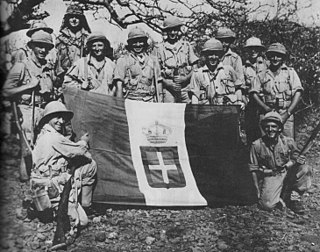
The East African campaign was fought in East Africa during the Second World War by Allies of World War II, mainly from the British Empire, against Italy and its colony of Italian East Africa, between June 1940 and November 1941. The British Middle East Command with troops from the United Kingdom, South Africa, British India, Uganda Protectorate, Kenya, Somaliland, West Africa, Northern and Southern Rhodesia, Sudan and Nyasaland participated in the campaign. These were joined by the Allied Force Publique of Belgian Congo, Imperial Ethiopian Arbegnoch and a small unit of Free French.

The military history of Ethiopia dates back to the foundation of early Ethiopian Kingdoms in 980 BC. Ethiopia has been involved in many of the major conflicts in the horn of Africa, and was one of the few native African nations which remained independent during the Scramble for Africa, managing to create a modern army. 19th and 20th century Ethiopian Military history is characterized by conflicts with the Dervish State, Mahdist Sudan, Egypt, and Italy, and later by a civil war.
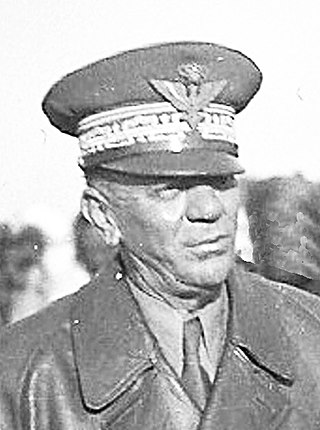
Luigi Frusci was an officer in the Italian Royal Army during the Italian conquest of Ethiopia and World War II. He was the last Italian Governor of Eritrea and Amhara.
The Order of battle of the East African campaign shows the ground forces of both sides in East Africa on the date that the Italians declared war on Britain and France, 10 June 1940 and for the British and Commonwealth forces involved in the 1941 offensive.

The Royal Corps Of Eritrean Colonial Troops were indigenous soldiers from Eritrea, who were enrolled as askaris in the Royal Corps of Colonial Troops of the Royal Italian Army during the period 1889–1941.

The 40th Infantry Division "Cacciatori d’Africa" was an infantry division of the Royal Italian Army during World War II. The Cacciatori d’Africa was formed on 27 July 1940 from troops and reservists stationed in Italian East Africa. The Cacciatori d’Africa, together with the 65th Infantry Division "Granatieri di Savoia" were outside the regular Royal Italian Army chain of command, and subordinated directly to Prince Amedeo, Duke of Aosta, the Viceroy of Italian East Africa. The division dissolved on 15 May 1941 after being decimated during the East African campaign.

The 65th Infantry Division "Granatieri di Savoia" was an infantry division of the Royal Italian Army during World War II. The Granatieri di Savoia was formed on 12 October 1936 in Littoria and disbanded on 20 April 1941 in Soddu, Ethiopia. The division's name translates as "Grenadiers of Savoy", with the House of Savoy being the ruling family of the Kingdom of Italy.

The Italian colony of Italian East Africa was composed of six governorates which made up the first level of country subdivisions for the colony.

Italians of Ethiopia are Ethiopian-born citizens who are fully or partially of Italian descent, whose ancestors were Italians who emigrated to Ethiopia starting in the 19th century during the Italian diaspora, or Italian-born people in Ethiopia.

Italian Ethiopia, also known as the Italian Empire of Ethiopia, was the territory of the Ethiopian Empire which was occupied by Italy for approximately five years. Italian Ethiopia was not an administrative entity, but the formal name of the former territory of the Ethiopian Empire which now constituted the Governorates of Amhara, Harar, Galla-Sidamo, and Scioa after the establishment of Italian East Africa.

The Royal Corps of Colonial Troops was a corps of the Italian Royal Army, in which all the Italian colonial troops were grouped until the end of World War II in North Africa campaign.
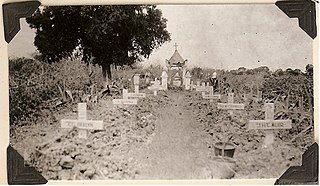
The Italian Somali Divisions were two divisions of colonial soldiers from Italian Somaliland that were formed as part of the Regio Esercito Royal Corps of Colonial Troops during the Second World War. In the Royal Corps of Colonial Troops, the units comprised the "101 Divisione Somala" and "102 Divisione Somala" and fought during the East African Campaign in 1941 before disbanding.
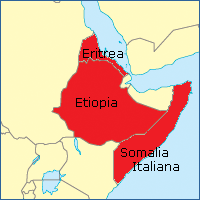
Operations on the Northern front, East Africa, 1940 in the Second World War, were conducted by the British in Sudan and the Armed Forces Command of Italian East Africa in Eritrea and Ethiopia. On 1 June 1940, Amedeo, Duke of Aosta the Viceroy and Governor-General of the Africa Orientale Italiana, commander in chief of the Armed Forces Command of the Royal Italian Army and General of the Air Force, had about 290,476 local and metropolitan troops and by 1 August, mobilisation had increased the number to 371,053 troops. General Archibald Wavell, General Officer Commanding-in-Chief (GOC-in-C) of Middle East Command, had about 86,000 troops at his disposal for Libya, Iraq, Syria, Iran and East Africa. About 36,000 troops were in Egypt and 27,500 men were training in Palestine.

The Battle of Agordat was fought near Agordat in Eritrea from 26 to 31 January 1941, by the Italian army and Royal Corps of Colonial Troops against British, Commonwealth and Indian forces, during the East African Campaign of the Second World War. The British had the advantage of breaking Italian codes and cyphers before the offensive and received copious amounts of information from Italian sources on the order of battle and plans of the Regia Aeronautica and the Italian army.

Eritrea requires its residents to register their motor vehicles and display vehicle registration plates.
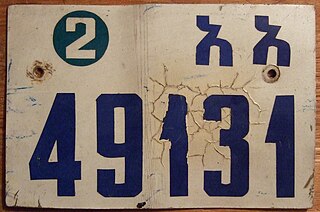
Ethiopia requires its residents to register their motor vehicles and display vehicle registration plates. Current plates feature Ge'ez text.

Somalia requires its residents to register their motor vehicles and display vehicle registration plates.






















